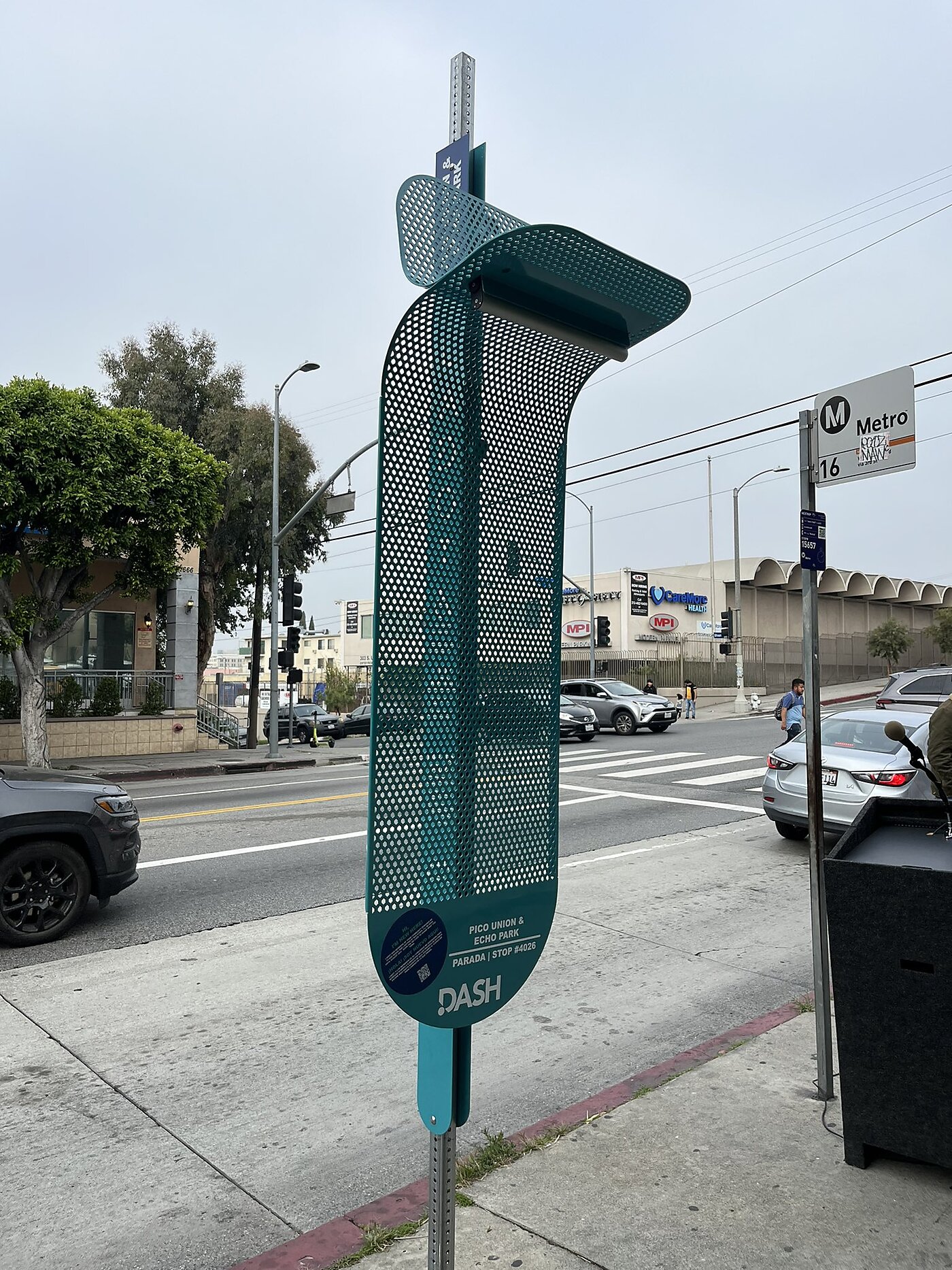
Paul Matzko
Los Angeles spent $200,000 on La Sombrita (‘“in the shade”), a bus stop shade/light structure that provides little shade or light. It has been almost too easy to criticize its design, the token DEI framing given to the project, how most of the funds went to a global junket for the designers, or the fact that city officials held a tone deaf celebratory press conference for its unveiling. Would this “make waiting for the bus at night [feel] safer” to you?
But La Sombrita isn’t really the problem. Rather, its failures are symptoms of its designers trying to work around deeper, structural problems with the governance of infrastructure in Los Angeles. Others have focused on how the shelter‐on‐a‐stick reveals the flaws of governance via non‐profit, the kludgery of excessive permitting, or “Blue America’s” systemic failures. There is plenty of blame to spread around, but I want to focus on what I believe is a more fundamental flaw that separates Los Angeles’s failures with transit infrastructure from those of even other progressive city governments.
But let’s start with the basics. Cities are paved heat sinks that get unbearably hot in the summers, especially for the poor bus riders waiting and baking for an average of 40 minutes (!) per day. They need shade from the sun, but only about 25% of bus stops in Los Angeles have shelters. Riders are left to squeeze themselves into the narrow shadows cast by utility poles.
Riders want LA to build more shelters. And the LA Metro wants to build more shelters. But most municipal bus systems already hemorrhage money — LA is on track to lose $1 billion a year by 2026 — and there’s no political will for raising fares to cover operating costs, let alone to fund new capital expenditures. And non‐bus riders don’t like being taxed to pay for stuff for bus riders. So how to pay for thousands of new bus shelters?
Well, what if I told you that don’t have to pay…anything? In 2000, someone offered to build and maintain thousands of bus shelters for Los Angeles for no upfront cost, even offering to return ~$6 million a year to the city for the privilege of doing so. Sounds too good to be true, eh? Hold that thought.
Yet that’s precisely what JCDecaux, a French company specializing in designing street furniture, promised to do. Over the next twenty years, JCDecaux promised to build 1,285 new shelters to join a few hundred already existing shelters. However, as the contract expired, they had built only a little over half of the promised shelters, just 660. The overwhelming majority of LA’s 8,100+ bus stops remain shelterless.
It’d be easy to blame JCDecaux for the failure, although the firm actually has a decent global track record of building street infrastructure. Still, the firm suffered from a malincentive problem. You see, JCDecaux offered to pay the upfront cost of the bus shelters because it would then have the exclusive right to sell advertising space on those shelters, splitting a share of that revenue with the city.
But that means JCDecaux’s goal is not to erect bus shelters that function as bus shelters per se. They are incentivized to put up bus shelters that maximize advertising revenue. And maximizing ad revenue means putting new shelters in wealthy neighborhoods rather than in the poor, underserved neighborhoods where more people actually ride the bus. That means that shelters are clustered in wealthy West LA.
In fact, having *people* in your bus shelter is actually a problem because they get in the way of the ads that are facing out at the cars driving by. As one urban planning professor put it, “The advertising company may be interested in putting their shelters on high‐traffic streets where there are relatively few people waiting for buses.” In other words, these are billboards first, bus shelters second. And Los Angeles banned most new billboards in 2002, which meant that the value of the bus shelter advertising substitute has since soared.
But the advertising malincentive explains suboptimal distribution of shelters, not why JCDecaux failed to build the stipulated total number of shelters. That is in large part a function of the byzantine tangle that is the shelter permitting process. To build each bus shelter, the company must get sign‐offs from eight discrete city agencies, an alphabet soup of bureaus and departments. That’s for every. single. shelter.
Each permission can take months or years to acquire, adding time and cost to each shelter. Furthermore, that process looks a little bit different — but just as cumbersome — in each of the other 88 cities and 20 smaller transit agencies in Los Angeles County. Contrast that with the fact that each shelter takes just two hours to install once approved.
In this regard, Los Angeles’ failure to build bus shelters resembles California’s (and the US’s) larger inability to build any kind of infrastructure in either a reasonable timeframe or at a sustainable cost. For example, anti‐development activists have gotten really good at weaponizing both federal and state environmental review laws to stymie infrastructure projects, even those that are environmentally beneficial like transmission lines for renewable energy. My favorite example is how the town of Woodside, California — median home price $5.5 million — declared itself a mountain lion habitat to avoid zoning reform that would’ve allowed denser housing to be built. The good news is that there is growing support on both sides of the partisan divide to reform some of the worst of those permitting delays.
But even as onerous as LA’s permitting system is, it mostly slowed down the progress of installing bus shelters rather than stopping construction altogether. There’s another factor that prevented many of the desired bus stops from being built at all.
Los Angeles is unique among major US cities for giving absolute veto power over bus shelters to city council members. And that veto doesn’t merely reside with the city council as a whole, but with every individual councilperson. Thus, if you’re JCDecaux, and you’ve spent years jumping through all the permitting hurdles for a shelter, and you’ve finally obtained the requisite eight sign‐offs, there’s one more boss battle to confront. You have to ask the councilperson whose district encompasses that bus shelter to give a gladiatoral thumb up or thumb down.
This is a shooting fish in a barrel scenario for NIMBYs, those who don’t want to see any new development built in their backyards. You see, only 9% of Los Angelenos commute via any form of mass transit, let alone via bus. Bus riders presumably want more bus shelters, but they can easily be out shouted by the other 91% of Angelenos who are worried that bus shelters are a visual blight, impair pedestrians, provide havens for the homeless, and so.
What happens is that Los Angeles council people express their theoretical desire for new bus shelters while blocking actually proposed bus shelters in their districts under pressure from store owners, anti‐development activists, and the like. I’m pro‐bus shelter but just not in my backyard.
That’s utterly bizarre. We don’t do other infrastructure projects like that. Imagine if every time a new traffic sign was proposed, your individual, local councilperson could veto it. People would lobby to stop these visual blights from being in front of their residences or places of business. Signs would cluster in poorer neighborhoods that have less political pull. It would be a mess.
Yet that’s why Los Angeles did. The reason why is even more bizarre. When JCDecaux was given its bus shelter contract, it also agreed to build 150 public toilets. But public toilets suck. They are exponentially more expensive to build and maintain, they aren’t worth much as advertising venues, and they’re even more wildly unpopular with their immediate neighbors. But building 150 toilets was the bitter pill that JCDecaux would swallow in exchange for getting up to 2,000 bus shelters/billboard substitutes.
However, JCDecaux’s contract only stipulated penalties if they built fewer than 15 toilets, so JCDecaux built precisely 15 new toilets and stopped. And that was a‑okay with anti‐development Los Angelenos, who didn’t want 150 public toilets in the first place. At the last second, they slipped the veto power into the bill so that they could win the fight block by block, toilet by toilet. Thus, the entire Los Angeles bus shelter program is in the proverbial shitter because local NIMBY activists created a NIMBY‐friendly council veto to block new toilets from being constructed. It was, to quote a retrospective, “a case study in how not to structure a contract for implementing bus shelters.” Indeed.
And that veto is the key difference between what happened with Los Angeles’ bus shelter program and similar programs in other cities. For instance, New York City also decided it needed more bus shelters. They also contracted with the same company to provide the shelters, JCDecaux. It’s also notoriously hard and expensive to build infrastructure in New York City, a place which spent $11 billion and took 50 years to build a single new train station.
Yet New York managed to build 3,500 new bus shelters in just 5 years. That compares to LA building 660 in 20 years, which means NYC built bus shelters at TWENTY-ONE TIMES the pace that LA did. LA deserves infinitely far more shade for that failure than even a thousand La Sombritas could ever provide!
To return to La Sombrita, the sum of money spent on the shade‐for‐nowhere project is a rounding error in the city budget. It isn’t the real problem, but it is a dead end. It only exists because it allowed the LA Metro to bypass the onerous permitting and veto regime by being relatively slim and pole‐mounted. But after having a short chuckle at La Sombrita, go ahead and fuhgettaboutit.
What should we do with what we’ve learned? In order of importance:
Don’t give individual veto power over infrastructure projects to local politicians.
Reform the permitting process to allow blanket approvals. For instance, New York stipulated that if the engineering bureau signed off on a structure design, its approval was good for all such structures. More, please.
Stop signing one‐size‐fits‐all, multi‐decade mega‐deals with big contractors. Auction off pole, parking, & right‐of‐way leases on something closer to an a la carte basis. Let a thousand flowers bloom when it comes to building and maintaining infrastructure.
Crossposted from the author’s Substack. Click through and subscribe for more posts on the intersection of history and policy.






